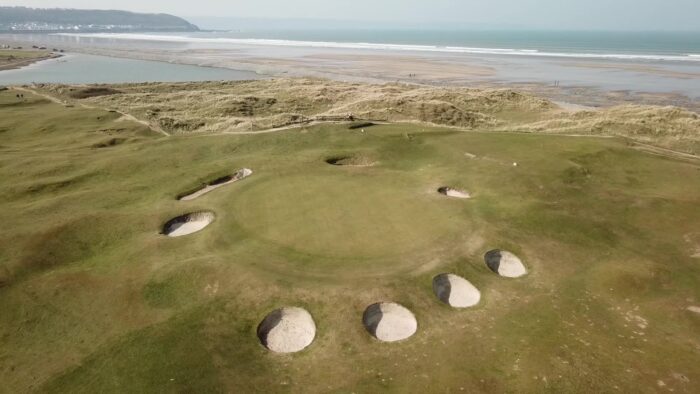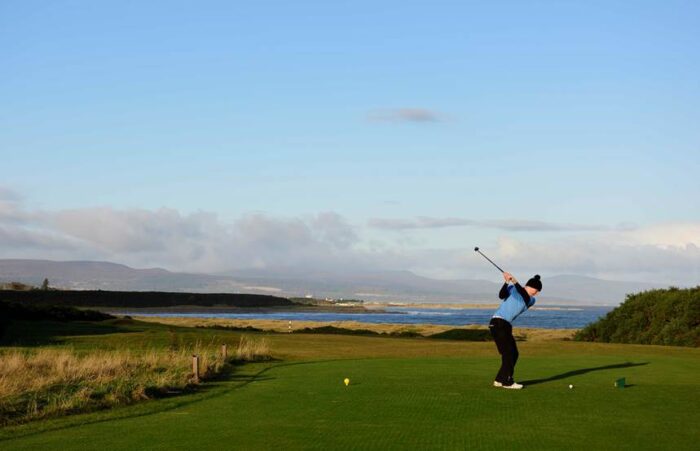Historic royal golf club is forced to dig up part of its course and move it
A royal golf club that dates back to 1864 is to dig up a part of its course and move it due to coastal erosion.
Since then, coastal erosion at the venue has got worse, as 20 feet of sand dune beside the seventh green has been washed away, with the green perilously close to the edge of the erosion. Last year Torridge District Council approved the golf club’s plans for a replacement eighth hole, tee and green, new ninth hole tees and amendments to the seventh hole green.
General manager Mark Evans has told The Telegraph that the decline of the course has been rapid, adding: “It has escalated over the last five years when we lost about 50 yards of land in depth and we lost the eighth tee four years ago.
“There is a lot of concern about the future – low lying golf courses are suffering. But we seem to be suffering more than most.
“We’ve just got a cobble ridge between us and the Atlantic which has been there 400 years. But it’s suffering these days.”
He estimates the end of the course near the sea may have just 20 years left.
The Environment Agency added: “We advise that all development is moved as far away from the coastline as possible.
“The new eighth tees are offered some protection by the rock armour, but this is not guaranteed for any length of time.

Royal North Devon. Image from Facebook
“We also advise that the existing seventh tees are moved inland where possible. There are significant erosion issues in this section at the moment.
“It is also worth noting that the proposed plan will only offer a temporary solution and further movement will be required in perhaps five to ten years.”
This comes as a three-year project to help restore a natural coastal defence at a royal golf club at the other end of the UK, Royal Dornoch Golf Club’s 10th fairway on the Struie Course, has stabilised the situation.
The hole was vulnerable to flooding and erosion and there were fears part of it could be lost.
The club therefore provided £10,000 a year towards the Green Shores project, based at the University of St Andrews, which investigated replanting saltmarsh habitat in the Dornoch Firth.
The project was part of a wider Scottish programme to recreate saltmarshes that has proven successful in the Eden Estuary in Fife, where erosion was causing concern for the St Andrews Links Trust.
Saltmarshes provide important habitat for a wide range of wildlife and can provide greater carbon storage than other natural habitats, important to redress climate change.
They also absorb wave energy and, wherever saltmarshes exist, the land behind is less likely to be eroded or flooded.
As part of the project, Royal Dornoch greenkeepers helped install biodegradable structures called bio-rolls to reduce wave action.
Pupils from Dornoch Academy also helped dig and replant saltmarsh transplants behind the bio-rolls.
A report on the project said flooding and erosion incidents have been increasing on the low-lying land on the northern shore of the Dornoch Firth and the natural fringe of saltmarsh grass habitat along the length of the firth’s shore has increasingly fragmented in recent years.
However, bio-roll protection overall increased the rate of success of those transplants actively growing at each site.
Its authors concluded that the project provided a rare example in Scotland of a nature-based solution that offers genuine potential to be successfully deployed around vulnerable, low-lying, soft coastal environments.
Dr Clare Maynard, from the University of St Andrews, said the bio-rolls had been hit by storms: “However, although the bio-rolls were battered, the ones that survived provided enough shelter to allow sediment to settle out of tidal waters.

Royal Dornoch. Image from Facebook
“This is a natural precursor to saltmarsh colonisation and demonstrates that we are a step closer to developing a continuous saltmarsh front for greater protection of the Struie Course.
“Creating natural flood defences, or building with nature, is not a quick fix, and although research-oriented in theory, relies heavily on trial and error when working practically.”
Neil Hampton, Royal Dornoch’s general manager, said: “We have been working hard to protect the Struie Course from coastal erosion.
He added: “Five or six years ago we thought we may have to move a fairway but now we are very confident that it will stay where it is and what we have is what we’ll keep for a long time.
“The last few years have been very positive and the fairway is now secure in its location.”















Coastal erosion is a challenge. Best of luck to Royal North Devon on their forced course alteration. #travel #golftourism #tourism #golftravel